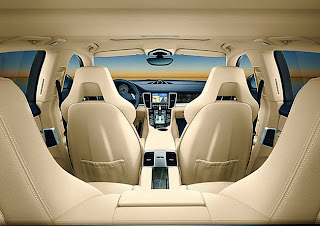Porsche launches the ultimate Panamera, and we are duly impressed.
Specifications
VEHICLE TYPE: front-engine, 4-wheel-drive, 4-passenger, 5-door hatchback
BASE PRICE: $174,175
ENGINE TYPE: twin-turbocharged and intercooled DOHC 32-valve V-8,
aluminum block and heads, direct fuel injection
Displacement: 293 cu in, 4806 cc
Power (SAE net): 550 hp @ 6000 rpm
Torque (SAE net): 590 lb-ft @ 2250 rpm
TRANSMISSION: 7-speed dual-clutch automatic
DIMENSIONS:
Wheelbase: 115.0 in Length: 195.7 in
Width: 76.0 in Height: 54.8 in
Curb weight (C/D est): 4450 lb
PERFORMANCE (C/D EST):
Zero to 60 mph: 3.0 sec
Standing ¼-mile: 11.4 sec
Top speed (mfr’s claim): 190 mph
FUEL ECONOMY (C/D EST):
EPA city/highway driving: 15/23 mpg
It’s not that any Porsche Panamera lacks power. The 300-hp V-6 is quick, the 380-hp hybrid and the 400-hp V-8 are quicker still, and the 500-hp Turbo—well, let’s just say we’ve squeezed a 3.3-second 0-to-60 run out of that 4400-pound rocket. But this is Porsche, and where a Turbo exists, a Turbo S isn’t far behind. So here is the Panamera Turbo S, more powerful by 50 hp, thanks to a modified ECU, and more responsive, thanks to modified turbochargers with titanium-aluminum turbine blades. The basic design of the Turbo model’s twin-turbocharged 4.8-liter V-8 remains unchanged.
The difference is not insignificant. The Panamera Turbo makes 516 lb-ft of torque in regular trim, and the Turbo S provides up to 553 lb-ft—or 590 with an overboost function. We estimate a 0-to-60-mph time of three seconds flat, and Porsche’s stated top speed rises by 2 mph to 190. There is one transmission: the excellent PDK, a ZF-sourced seven-speed dual-clutch automatic. It routes power to all four wheels, with a noticeable bias toward the rearmost pair.
Germans Have All the Fun
Few Panamera owners are as fortunate as those on the car’s German home turf, where it is legal to take it up to its top speed, so unless you like jail—and what Porsche owner with 175 large lying around doesn’t—you’ll have to take our word for the ultra-high-speed performance of this car. At virtually any velocity, this quickest of the four-door Porsches will charge forward with a menacing growl. It’s unlike, say, the Mercedes-Benz S600 or the BMW 760i, in which speed builds in surreal silence, and it doesn’t take a very long stretch of road to max out the Panamera. That’s not to say it’s a white-knuckle affair. This Turbo S masks actual speed very well, and 120 mph feels like 70. Remarkably, however, the Panamera might be even more efficient at killing speed than building it up, especially when equipped with the optional carbon-ceramic brakes, which bite instantly and aggressively.
Still, by definition and by its somewhat clumsy styling, the Panamera is not a sports car, and this four-door hatchback sedan tips the scales at well over two tons. Thankfully, the chassis does a far better job of masking the Panamera’s size and mass than does its chubby sheetmetal. The hydraulic steering is nicely weighted and provides linear feedback. Among luxury liners, the Panamera is clearly the best handling, with impeccable stability and precise turn-in, despite having to swing around the heavy V-8 and its turbo accouterments. The torque-vectoring system included with the standard Porsche Dynamic Chassis Control basically forces the Panamera into corners and makes it virtually impossible to throw the car off course with anything less than wildly exaggerated inputs and insane entry speeds. The car is ever vigilant for that stuff, though:. It’s impossible to turn off the stability-control system entirely, even if the button labeled “off” suggests otherwise. If the car is out of sorts and you tap the brakes, the system always kicks in.

Beautiful Inside, at Least
As in other Panameras, the Turbo S’s front- and rear-seat room is adequate for its class of short-wheelbase luxury cars, and the tall center console front and rear is nicely styled and looks expensive and tasteful. Being sealed inside would be a flawless experience if not for the occasional creak and a few joints and seams that aren’t up to, say, Audi standards.

Source : http://www.caranddriver.com/
 10:13 PM
10:13 PM
 Admin
Admin










